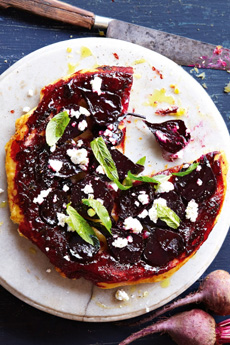RECIPE: Beet Tarte Tatin
 Beet Tarte Tatin. Photo and recipe courtesy Taste.com.au. |
If you love the combination of beets and goat cheese, try this recipe for Beet Tarte Tatin. We adapted it from one by Katrina Woodman, originally published in the October 2012 of Australian Good Taste. The Tatin sisters, Caroline and Stéphanie, ran the Hotel Tatin in Lamotte-Beuvron, southwest of Paris in the Loire Valley, not far from the town of Chambord. Tarte Tatin is a one-crust fruit pie invented by accident in France in the early 1880s. It is served upside-down; the fruit (initially, it was apples) are on the bottom with the crust on top. As the story goes, Stéphanie, preparing an apple tart, erroneously put the apples in the pan without the crust underneath. The apples caramelized, the customers loved it and the Tarte Tatin was born. It can be made with sweet vegetables as well: beets and carrots are delicious prospects. This vegetable Tatin, cooked in a skillet, serves four as an appetizer or as part of a light lunch, with a salad. |
|
|
RECIPE: BEET TARTE TATIN Ingredients For 4 Servings |
||
|
Preparation 1. PREHEAT oven to 390°F. 2. MELT the butter in a ovenproof non-stick 7″ or 8″ frying pan over medium-high heat. Stir in the beets and cook for 2 minutes. Add the sugar, vinegar and thyme. Season. Cook, stirring, for 2 minutes or until mixture thickens. 3. COVER with foil and bake for 20 minutes or until the beetroot is just tender. Set aside for 5 minutes to cool. Increase oven heat to 430°F. 4. TRIM the pastry into a 9″ to 10″ disc, depending on size of pan. Arrange the beets evenly over the base of the pan. Top with pastry. Fold in excess. Bake for 20 minutes or until puffed and golden. Cool in the pan for 10 minutes. 5. PLACE a plate turned upside down over the frying pan (it should be bigger than the pan). Holding the two together, flip the entire pastry over. Top with goat cheese and herbs and serve warm. |
 A taproot system versus conventional fibrous roots. Here’s more about it from Britannica.com. |
|
|
BEET VS. BEETROOT Beetroot (Beta vulgaris) evolved from the wild seabeet, a leafy plant that grows at coastlines around the world. It was first domesticated in the eastern Mediterranean and Middle East, although it was only the leaves that were eaten back then. (The wild seabeet is also the common ancestor of spinach and chard.) The Romans began to cultivate beets in earnest, cooking them with honey and wine. Recipes in oldest surviving cookbook De Re Coquinaria by Apicius’s, included beetroot in broths and salads, the latter with a very modern-sounding vinaigrette of mustard, oil and vinegar. The beet is a plant with a taproot system. The taproot is a large, central, dominant root, typically straight and very thick, tapering downward (see image above). For most of its life, beetroot was long and thin like a carrot or parsnip—both taproots, along with burdock, radish and turnip, among others. The familiar round shape was developed in the 16th century. Beetroot continued to grow in popularity in Victorian times, favored for its dramatic color in salads and soups. It was also used as a sweet ingredient in cakes and puddings. Beet sugar, used more widely around the world than cane sugar, was made by boiling all the sugar out of the beets, then cooking down that sugary water into dry crystals. Today, as a result of mutation and selective breeding, beets are available in numerous shapes and sizes, including orange, yellow, white and candy-striped (with red and white concentric circles). The term beetroot is used in the U.K., France and elsewhere. It is known by its shorter name, beet, in North America. |
||